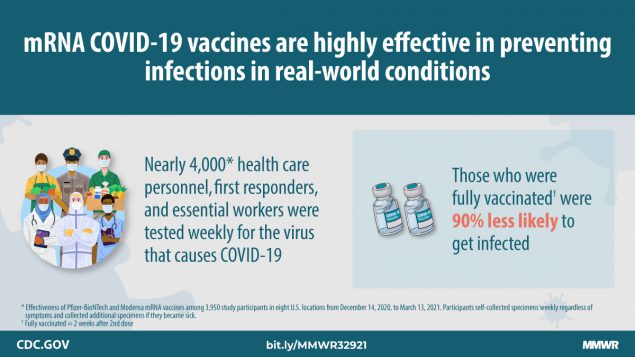
New research from the CDC confirms the very robust real-world efficacy of messenger RNA vaccines in people with a high occupational risk of SARS-CoV-2 infection.
The BNT162b2 (Pfizer/BioNTech) and mRNA-1273 (Moderna) mRNA vaccines were found to be 90% effective two weeks or more after full vaccination in health care workers, first responders, and other essential workers in the study, which included 3,950 people in six states followed for a 13-week period from Dec. 14, 2020 through March 13, 2021. Following a single dose of either of the two-dose mRNA vaccines, infection risk was reduced by 80% after two weeks.
Study findings were published on Monday, March 29, in the CDC’s Morbidity and Mortality Weekly Report.
CDC director Rochelle P. Walensky, MD, MPH, said in a statement that the real-world findings in people with a high-risk of occupational exposure to Covid-19 shows that national vaccination efforts are working. “These findings should offer hope to the millions of American receiving Covid-19 vaccines each day and to those who will have the opportunity to roll up their sleeves and get vaccinated in the weeks ahead,” she said.
However, in a White House Covid-19 briefing, also held on Monday, Walensky struck a very different tone, warning of a feeling of “impending doom” if the pace of vaccination slows and proven infection mitigation protocols like social distancing and mask wearing are abandoned too quickly.
“We have so much to look forward to, so much promise and potential of where we are, and so much reason for hope, but right now I’m scared,” she said. She noted that the most recent CDC data showed the 7-day average of new cases to be slightly less than 60,000 cases per day, which represents a 10% increase over the prior week.
“The trajectory of the pandemic in the United States looks similar to many other countries in Europe, including Germany, Italy, and France… just a few weeks ago. And since that time, those countries have experienced a consistent and worrying spike in cases,” she said.
Participants in the CDC study self-collected nasal swabs, and the samples and RT-PCR testing for SARS-CoV-2 was performed on all samples during the 13 weeks of their trial observation period from mid-December of last year to mid-March of this year.
A total of 2,479 (62.8%) participants received both doses of an mRNA vaccine during the study period and 477 (12.1%) had received a single dose.
Roughly half of the study subjects (52.6%) were from study sites in Arizona, and participants included physicians and other clinical leads (primary health care personnel; 21.1%), nurses and other allied health care personnel (33.8%), first responders (21.6%), and other essential and front-line workers (23.5%).
The majority were female (62.1%), age 18–49 years (71.9%), White (86.3%), and non-Hispanic (82.9%), and more than half had no chronic medical conditions (68.9%). During the 13-week study period, adherence to weekly surveillance reporting and specimen collection was high (median: 100%; interquartile range 82%–100%).
The majority (62.7%) of vaccinated participants received BNT162b2, and roughly 30% received mRNA-1273.
Among the main study findings:
- During the 116,657 person-days when participants were unvaccinated, 161 PCR-confirmed infections were identified (incidence rate = 1.38/1,000 person-days).
- During the 13 days after first-dose or second-dose vaccination when immune status was considered indeterminate (67,483 person-days), 33 PCR-confirmed infections were identified and excluded from the outcome. Two sources of partially immunized person-days were reported.
- Five PCR-confirmed infections were reported during 15,868 person-days ≥14 days after their first dose among those who did not receive their second dose during the study period; three PCR-confirmed infections were reported during 25,988 person-days ≥14 days after the first dose and through receipt of the second dose.
Eight PCR-confirmed infections occurred during 41,856 person-days with partial immunization (≥14 days after first dose and before second dose; incidence rate = 0.19/1,000 person-days) and 3 PCR-confirmed infections occurred during 78,902 person-days with full immunization (≥14 days after second dose; incidence rate = 0.04/1,000 person-days).
Estimated adjusted vaccine effectiveness of full immunization was 90% (95% CI, 68%–97%); vaccine effectiveness of partial immunization was 80% (95% CI, 59%–90%). In sensitivity analyses, inclusion of other covariates (sex, age, ethnicity, and occupation) were entered individually in the vaccine effectiveness model; the change in vaccine effectiveness point estimates was <3%.
Mark G. Thompson, PhD, of the CDC’s Covid-19 Response Team and colleagues, concluded that the interim vaccine effectiveness findings for the two approved mRNA vaccines in real-world experience “complement and expand upon the vaccine effectiveness estimates from other recent studies and demonstrate that current vaccination efforts are resulting in substantial preventative benefits among working-age adults.”
-
A new study from the CDC confirms the very robust real-world efficacy of messenger RNA vaccines in people with a high occupational risk of SARS-CoV-2 infection.
-
Estimated adjusted vaccine effectiveness of full immunization was 90% (95% CI, 68%–97%); vaccine effectiveness of partial immunization was 80% (95% CI, 59%–90%).
Salynn Boyles, Contributing Writer, BreakingMED™
This study was funded by the U.S. Centers for Disease Control and Prevention.
None of the researchers reported disclosures that were related to the study.
Cat ID: 190
Topic ID: 79,190,730,933,190,926,192,927,151,928,925,934


